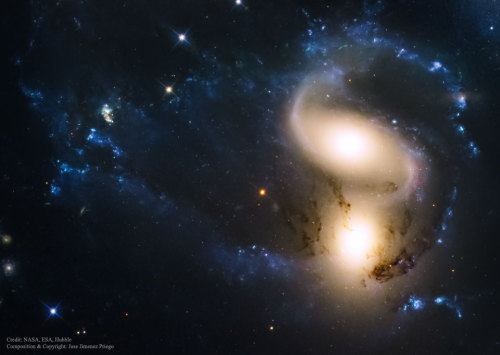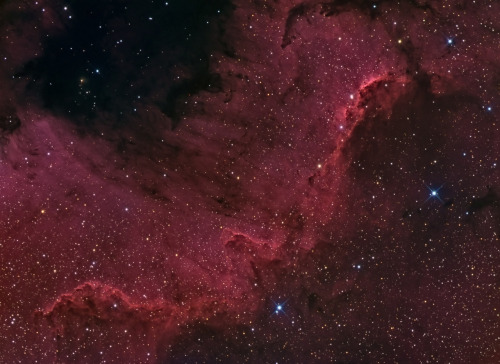Colliding Galaxies NGC 7318, Part Of Stephan’s Quintet

Colliding Galaxies NGC 7318, part of Stephan’s Quintet
More Posts from Littlecadet-biguniverse and Others
Hubble Peers into the Storm
NASA - Hubble Space Telescope patch. Sept. 9, 2016
This shot from the NASA/ESA Hubble Space Telescope shows a maelstrom of glowing gas and dark dust within one of the Milky Way’s satellite galaxies, the Large Magellanic Cloud (LMC). This stormy scene shows a stellar nursery known as N159, an HII region over 150 light-years across. N159 contains many hot young stars. These stars are emitting intense ultraviolet light, which causes nearby hydrogen gas to glow, and torrential stellar winds, which are carving out ridges, arcs, and filaments from the surrounding material. At the heart of this cosmic cloud lies the Papillon Nebula, a butterfly-shaped region of nebulosity. This small, dense object is classified as a High-Excitation Blob, and is thought to be tightly linked to the early stages of massive star formation.
Hubble orbiting Earth
N159 is located over 160,000 light-years away. It resides just south of the Tarantula Nebula (heic1402), another massive star-forming complex within the LMC. This image comes from Hubble’s Advanced Camera for Surveys. The region was previously imaged by Hubble’s Wide Field Planetary Camera 2, which also resolved the Papillon Nebula for the first time. Related links: heic1402: https://www.spacetelescope.org/news/heic1402/ Hubble’s Wide Field Planetary Camera 2: https://www.spacetelescope.org/about/general/instruments/wfpc2/ For more information about the Hubble Space Telescope, visit: http://hubblesite.org/ http://www.nasa.gov/hubble https://www.spacetelescope.org/ Image, Video, Text, Credits: ESA/Hubble & NASA/Text credit: European Space Agency/NASA/Karl Hille. Greetings, Orbiter.ch Full article
(NASA)
The Juno spacecraft just recorded these creepy sounds around Jupiter
Via Science Alert


The Milky Way was so very alive this weekend in the backcountry.. Hope you all had a chance to look up and watch the cosmos whiz by.. #stars #nightphotography #nightsky #darksky #adventure

The Running Chicken Nebula.
Image Credit & Copyright: Andrew Campbell

M7: Open Star Cluster in Scorpius : M7 is one of the most prominent open clusters of stars on the sky. The cluster, dominated by bright blue stars, can be seen with the naked eye in a dark sky in the tail of the constellation of the Scorpion . M7 contains about 100 stars in total, is about 200 million years old, spans 25 light-years across, and lies about 1000 light-years away. The featured wide-angle image was taken near the city of Belo Horizonte in Brazil. The M7 star cluster has been known since ancient times, being noted by Ptolemy in the year 130 AD. Also visible are a dark dust cloud on the lower right, and, in the background, literally millions of unrelated stars towards the Galactic center. via NASA
js

A cosmic concoction in NGC 2467
js

Southern NGC7000
js
What is the difference between a supernova and a hypernova?
That’s a really good question, and the simple answer is that a hypernova produces way more energy than a standard supernova. Supernovae are known as being bright explosions from massive stars, and their remnant is usually a neutron star.

Hypernovae, however, more commonly produce black holes due to being from stars more massive than those that cause supernovae. Often time, they appear brighter too, which is why an alternate name for hypernovae is “superluminous supernovae”. Hypernovae are sometimes also the cause of gamma-ray bursts, a dangerous release of energy so high that it will fry anything in its path.

Thanks for asking! :)

NGC 2736: The Pencil Nebula
js

Wide-field view of the sky around the exotic binary star system AR Scorpii
This wide-field image from the Digitized Sky Survey 2 shows the rich starfields surrounding the exotic binary star system AR Scorpii.
Credit: Digitized Sky Survey 2. Acknowledgement: Davide De Martin
-
 sheslikeaferriswheel reblogged this · 7 months ago
sheslikeaferriswheel reblogged this · 7 months ago -
 foulphantomfury reblogged this · 3 years ago
foulphantomfury reblogged this · 3 years ago -
 byrafayozef liked this · 3 years ago
byrafayozef liked this · 3 years ago -
 lagranbruja reblogged this · 4 years ago
lagranbruja reblogged this · 4 years ago -
 dailypicsoftheuniverse liked this · 4 years ago
dailypicsoftheuniverse liked this · 4 years ago -
 automaticdestinytrash reblogged this · 5 years ago
automaticdestinytrash reblogged this · 5 years ago -
 automaticdestinytrash reblogged this · 5 years ago
automaticdestinytrash reblogged this · 5 years ago -
 automaticdestinytrash reblogged this · 5 years ago
automaticdestinytrash reblogged this · 5 years ago -
 automaticdestinytrash reblogged this · 5 years ago
automaticdestinytrash reblogged this · 5 years ago -
 automaticdestinytrash reblogged this · 5 years ago
automaticdestinytrash reblogged this · 5 years ago -
 zzyrae liked this · 5 years ago
zzyrae liked this · 5 years ago -
 elzfiles reblogged this · 5 years ago
elzfiles reblogged this · 5 years ago -
 elzfiles liked this · 5 years ago
elzfiles liked this · 5 years ago -
 superbhoundtrashrascal liked this · 5 years ago
superbhoundtrashrascal liked this · 5 years ago -
 toastytune reblogged this · 5 years ago
toastytune reblogged this · 5 years ago -
 saccidananda liked this · 5 years ago
saccidananda liked this · 5 years ago -
 xinfierno liked this · 5 years ago
xinfierno liked this · 5 years ago -
 darkarchitectureeducationpony liked this · 5 years ago
darkarchitectureeducationpony liked this · 5 years ago -
 hermit-hedge liked this · 5 years ago
hermit-hedge liked this · 5 years ago -
 bundle-of-penguins reblogged this · 5 years ago
bundle-of-penguins reblogged this · 5 years ago -
 kavemankiel reblogged this · 5 years ago
kavemankiel reblogged this · 5 years ago -
 destructospin reblogged this · 5 years ago
destructospin reblogged this · 5 years ago -
 destructospin liked this · 5 years ago
destructospin liked this · 5 years ago -
 lecoleo-blog liked this · 5 years ago
lecoleo-blog liked this · 5 years ago -
 theycallmekingsley liked this · 5 years ago
theycallmekingsley liked this · 5 years ago -
 meggriffinislost reblogged this · 5 years ago
meggriffinislost reblogged this · 5 years ago -
 laetitiaportalchupinsworld liked this · 6 years ago
laetitiaportalchupinsworld liked this · 6 years ago -
 x-heesy liked this · 6 years ago
x-heesy liked this · 6 years ago -
 flying-butter liked this · 6 years ago
flying-butter liked this · 6 years ago -
 moominsaima liked this · 6 years ago
moominsaima liked this · 6 years ago -
 drinperquku-blog liked this · 6 years ago
drinperquku-blog liked this · 6 years ago -
 thirdman000 reblogged this · 6 years ago
thirdman000 reblogged this · 6 years ago -
 imartistry21 reblogged this · 6 years ago
imartistry21 reblogged this · 6 years ago -
 imartistry21 liked this · 6 years ago
imartistry21 liked this · 6 years ago -
 looking-for-the-great-unknown liked this · 6 years ago
looking-for-the-great-unknown liked this · 6 years ago -
 love-naturaal reblogged this · 6 years ago
love-naturaal reblogged this · 6 years ago -
 explosionlove-blog1 liked this · 6 years ago
explosionlove-blog1 liked this · 6 years ago
GREETINGS FROM EARTH! Welcome to my space blog! Let's explore the stars together!!!
144 posts